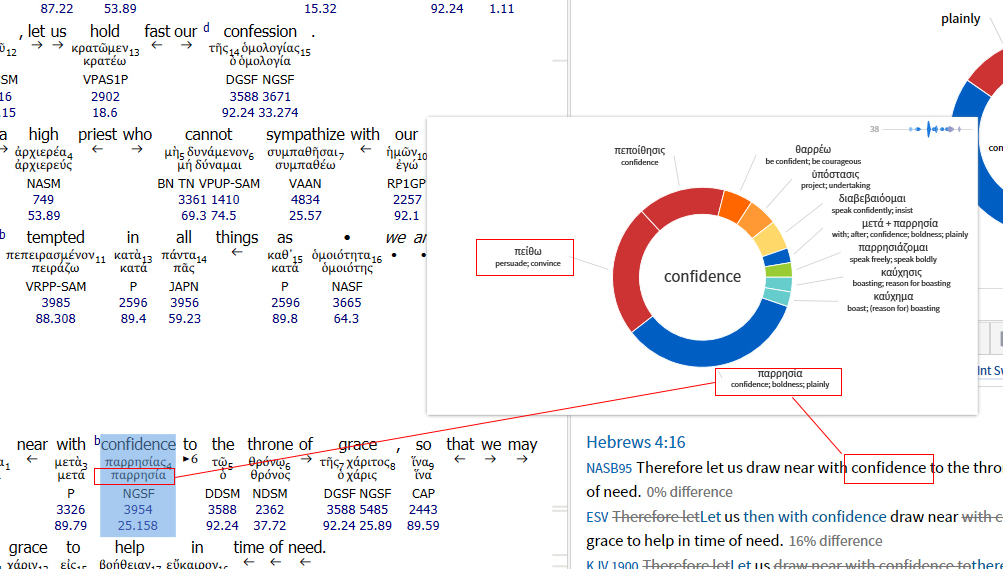This post is about how to gather, sort, filter, and orchestrate words from root Scripture languages to get at a New or Old Testament author’s intended word meaning. It’s about how to do Bible word analysis and avoid false interpretation or erroneous meaning from Scripture.
Method of Biblical Word Study
For purposes of consistency and as a repeatable exegetical methodology, it is an efficient use of time and effort to do Bible word studies with a proven and well-developed process. This post outlines a process where the analysis guidelines are given by the “Grasping God’s Word” [1] text is adapted to this Bible word analysis method with Logos software.
This walk-through is a highly useful method for carrying out Bible word studies, and it is now central to a personal workflow. The same process is suitable for both the Old and New Testaments and can be done both manually or automatically to a limited extent.
Select Word for Study
- Words that are crucial to a Scripture passage.
- Repeated words.
- Figures of speech.
- Words that are unclear, puzzling, or difficult.
The outline given below makes trial use of the chosen word “confidence” in Hebrews 4:16 NASB and ESV.
“Therefore let us draw near with confidence to the throne of grace, so that we may receive mercy and find grace to help in time of need. ” – Hebrews 4:16
Determine Semantic Range
Gather a listed range of all possible word definitions using a standard English dictionary.
Do Concordance Work
Determine what the word could mean from the original Hebrew or Greek language. This is a further narrowing of the semantic range as it becomes recognized what the words mean in that language. From the original manuscript word, isolate the other word terms to identify their meaning from the reading of the text. In this example, the Greek word for “παρρησία” (parrēsia) could mean “confidence,” “plainly,” “boldness,” “public, publicity,” or “openly, openness.”
Several modern Bible translations can now align with one another as the word chosen for analysis become compared between text translators. All translations taken together in the concurrently listed form should translate from the same original word.
Drill down into the circular word definition segment to separate the term given in Greek. By extracting this term for greater precision, it then becomes possible to see the differences among all variability. By process of elimination, we can from there conclude the word has a “confidence, boldness, plainly” meaning. As compared, for example, to “persuade” or “convince,” which isn’t the rendered word used by the author. We can, therefore, understand from the word choice that a person isn’t to approach the throne of grace of the LORD Most High to “persuade” or “convince”.This method can sometimes reconcile rendered word differences between various formal or informal Bible translations.
Examine the Context of Word Analysis
This is a crucial step to determine what the word could mean. From the chosen word for study, examine other sources of context located among biblical passages, as indicated in this diagram below. Imagine this diagram as a 3D Venn-type illustration. With the chosen word study at the top and its surrounding concentric circles of context beneath, examine progressive levels of context while extending outward. Each circle supports or reinforces its suitable meaning.
Look up all verses associated with the separated word to identify commonalities in meaning elsewhere. With the same author and then all verses together that make use of the specific word through the same covenant (OT or NT).
To assure faulty logic is not applied to word analysis and arrive at a false conclusion, test, or screen the rationale for a prospective and interpreted meaning. Specifically, this is to check tentative findings against any potential pitfalls. If the word-analysis fails any of these tests, the process must begin again. The process must remain iterative until there is a high degree of certainty about a word’s interpreted meaning.
Watch for Fallacies of Interpretation
English-Only Fallacy
This occurs when you base your word study on the English word rather than the underlying Greek or Hebrew word.
Root Fallacy
Falsely concludes that the real meaning of a word always comes from the original root or etymology of the word. For example, a butterfly is not a fly soaked, or coated in butter.
Time-Frame Fallacy
This occurs when the definition or meaning of a term in modern use is read back into Scripture, or applied to biblical times.
Overload Fallacy
An acceptance that a word means every definition within its semantic range.
Word-Count Fallacy
To conclude that a word has the same meaning every time it occurs.
Word-Concept Fallacy
A false assumption that the full meaning of a concept is the same as the meaning of a single word. The meaning of a concept is bigger than a single word.
Selective-Evidence Fallacy
Choosing an interpreted word that matches our preference while we dismiss evidence that contradicts our view.
Specifically, for the verse interpreted inside the passage and within context, it is safe to conclude and accept the intended meaning of the word.
[1] J Scott Duvall and J. Daniel Hays, Grasping God’s Word, 3rd ed. (Grand Rapids, MI: Zondervan, 2012), 163 – 184.
[2] Ibid. 177.
[3] Ibid. 164 -166.















